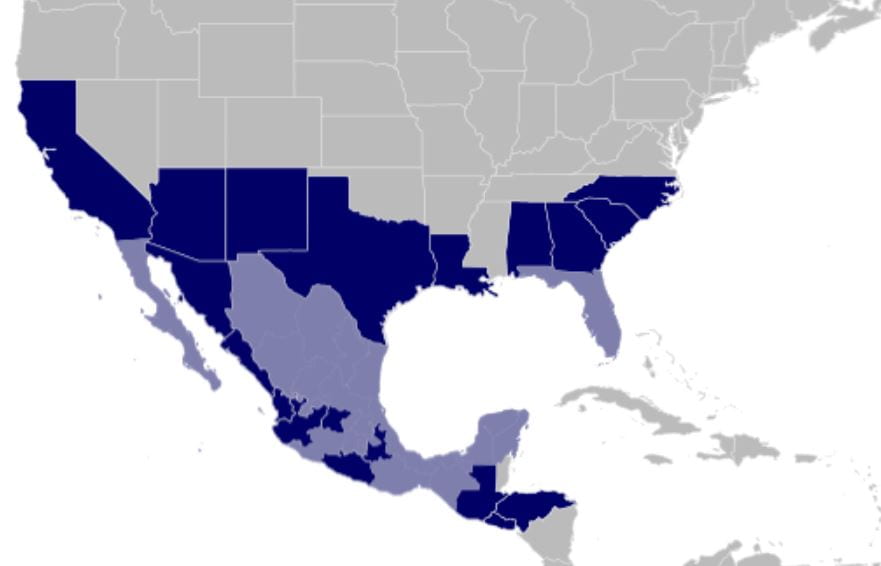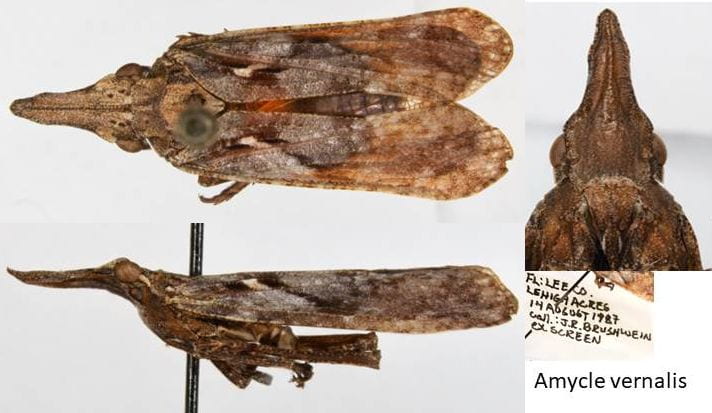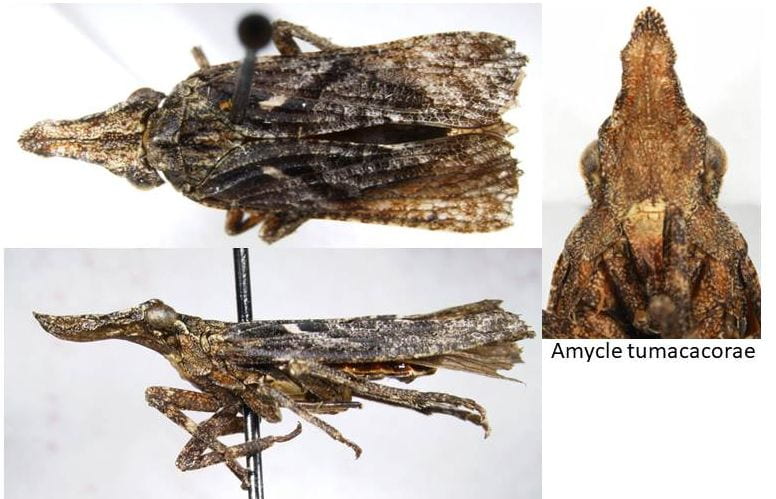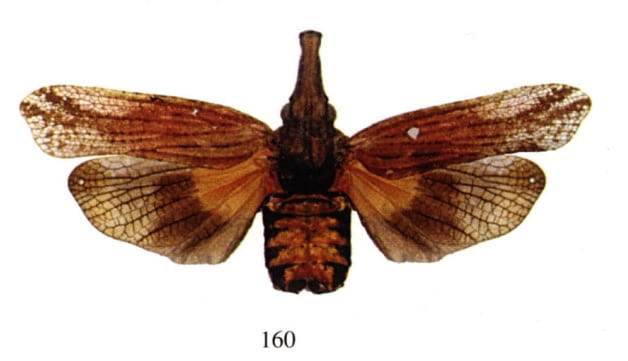[Back to North American Fulgoridae]
Family Fulgoridae Latreille, 1807
Subfamily Amyclinae Metcalf, 1938
Tribe Amyclini Metcalf, 1938
Genus Amycle Stål, 1861
Type species (in original combination): Fulgora (Episcius?) amabilis Westwood, 1842.
Synonyms
None.
Distribution
Southwestern US, Central & South America.
Recognized species
There are 9 species currently assigned to this genus (4 in the US), as follows. [see Metcalf 1947: 101].
Amycle amabilis (Westwood, 1842: 119) – Mexico, Guatemala
= Fulgora (Episcius (?)) amabilis Westwood, 1842: 119.
= E[piscius] amabilis (Westwood, 1842), comb. by Schaum, 1850: 65
= A[mycle] amabilis (Westwood, 1842), comb. by Stal, 1861: 148.
= Cyrpoptus] (Amycle [sic]) amabilis (Westwood, 1842), comb. by Stal, 1862: 305 (and 1864: 50).
= Amycle amabilis (Westwood, 1842), comb. by Distant, 1894: 26.
Amycle brevis O’Brien, 1988: 142 – Mexico (Nayarit, Guerrero)
Amycle grandis O’Brien, 1988: 142 – Mexico (Sinaloa, Sonora, and ? Jalisco)
Amycle mankinsi O’Brien, 1988: 142 – Honduras
Amycle pinyonae Knull & Knull, 1947 – USA: AZ, CA, NM
Amycle saxatilis Van Duzee, 1914: 33 – USA: CA
Amycle sodalis Stål, 1861: 148 – Mexico (Atlixco, Canada de Negros, Cordoba, Huachinango)
Amycle tumacacoriae Knull & Knull, 1947 – USA: AR, AZ, OK, TX
Amycle vernalis Manee, 1910: 117 – USA: AL, FL, GA, LA, NC, SC, TX
Economic Importance
Limited.
Plant associations
Amycle vernalis – Eragrostis curvula (Schrad.) Nees (weeping lovegrass, Poaceae), Schizachyrium scoparium (Michx.) Nash (little bluestem), Andropogon ternarius Michx. (splitbeard bluestem), A. virginicus L. (broomsedge bluestem), Danthonia sericea Nutt., and Deschampsia flexuosa (L.) Trin..
Amycle pinyonae – Pinus cembroides Zucc. (Pinales, Pinaceae)
Hosts from O’Brien (1988), Wheeler & Wilson (2005, 2010) (none in Wilson et al. 1994) see also FLOW; plant names from USDA PLANTS or Tropicos.
Recognition
Head strongly anteriorly produced (one of only 3 fulgorid genera north of Mexico); cephalic process narrowed apically, flattened dorsoventrally; vertex elongate triangular, base nearly twice as wide as apex (vs. Rhabdocephala and Scolopsella).
O’Brien (1988) presents a key to the species of Amycle here, reproduced verbatim (possibly with OCR typos), with light editing, as follows:
Key to the Species of Amycle
1. Hind wing with 2 colors, brown posterior and base white, yellow, pink, or red (Fig. 93) – Amycle saxatilis Van Duzee
1.’ Hind wing with 3 colors, brown posterior, translucent area (Figs. 94-101), and base white, yellow, orange, or red – 2
2(1). Base of hind wing yellow, white, or pink – 3
2’. The base of hind wing red or orange – 4
3(2). The base of the hind wing yellow or yellow-orange, contiguous with brown suffusion, apical area lightly
suffused with brown, intermediate area translucent (Fig. 101) – Amycle amabilis (Westwood)
3’. The base of the hind wing pale pink, contiguous with a white band, posterior margin brown (Fig. 97); sides of head process parallel (Fig. 18) –Amycle vernalis Manee
4(2). Vertex at least twice as long as broad (Figs. 17-21) – 5
4’. Vertex less than twice as long as broad (Figs. 14, 15) – 8
5(4). Hind wing with brown apical and anal areas contiguous (Figs. 93-97) – 6
5’. Hind wing with a transparent area between brown apical and anal areas (Figs. 98-100) – 7
6(5). Hind wing with transparent area restricted to narrow anterior band (Fig. 94); head process parallel-sided (Fig. 20) – Amycle sodalis Stål
6’. Hind wing with a transparent area about 1/4 area of wing (Fig. 9.5); head process subtriangular (Fig. 21) – Amycle mankinsi O’Brien.
7(5). Head process expanded at tip (Fig. 19); hind wing with red area separated from brown anal and apical areas by the transparent band (Fig. 98) – Amycle grandis O’Brien
7’. Head process subtriangular (Fig. 17); red area and brown anal area contiguous (Fig. 100) – Amycle tumacacoriae Knull & Knull
8(4). Head broader than long (Fig. 14); apex of hind wing narrowly brown (Fig. 99) – Amycle brevis O’Brien
8’. Head longer than broad (Fig. 15); apex of hind wing broadly brown (Fig. 96) – Amycle pinyonae Knull & Knull
O’Brien (1988), figures 14-23 (may be some typos in the OCR). Head and thorax, dorsal view: 14, Amycle brevis O’Brien, 15, A. pinyonae Knull & Knull; 16, A. saxatilis Van Duzee; 17, A. tumacacoriae Knull & Knull; 18, A. vernalis Manee; 19, A. grandis O’Brien; 20, A. sodalis Stal; 21, A. manhinsi O’Brien; 22, A. amabilis(Westwood); 2.3, Rhabdocephala brunnea Van Duzee.

O’Brien (1988), figures 93-101 Hind wings of Amycle: 93, A. saxatilis Van Duzee, 94. A. sodalis Stal, 95. A. mankinsi O’Brien, 96. A. pinyonae K & K, 97. A. vernalisManee, 98, A. grandis O’Brien, 99 A brevis O’Brien; 100, A. tumacacoriaeK & K, 101, A. amabilis (Westwood).
Online resources
Bugguide.
iNaturalist.
FLOW.
EOL.
GBIF.
BOLD.
GenBank.
3i.
Discover Life.
Collecting
Adults are taken sweeping, beating, or inspection of hosts. Wheeler & Wilson (2005) report Amycle were sampled by
holding a white enamel pan at the base of grass, striking the crown with an ax handle, and collecting dislodged adults and nymphs.
Molecular resources: Genbank has several genes for Amycle vernalis; Barcode of Life has data for Amycle vernalis and A. saxatilis.
Selected references
Knull, D. J. and J. N. Knull. 1947. Two new Amycle (Homoptera: Fulgoridae). Annals of the Entomological Society of America 60: 397-400.
Latreille, P. A. 1807. Sectio secunda. Familia quarta. Cicadariae. Cicadaires. Genera Crustaceorum et Insectorum secundum ordinem naturalem in familias disposita, iconibus exemplisque plurimis explicata 3: 1-258.
Manee, A. H. 1910. Two new Fulgorids (Hemiptera-Homoptera). Entomological News. Published by the American Entomological Society 21: 117.
Metcalf, Z. P. 1938. The Fulgorina of Barro Colorado and other parts of Panama. Bulletin of the Museum of Comparative Zoology, Harvard Coll. 82: 277-423. [Fulgoridae p. 342]
Metcalf, Z. P. 1947. General Catalogue of the Homoptera. Fascicle IV Fulgoroidea. Part 9 Fulgoridae. Smith College, Northhampton, Massachusetts. (p. 101)
O’Brien, L. B. 1988. New World Fulgoridae, part 1: genera with elongate head processes. Great Basin Naturalist Memoirs 12: 135-170.
Porion, T. 1994. Fulgoridae I: catalogue illustre de la faune americaine. Sciences Nat, Venette.
Stål, C. 1861. Miscellanea hemopterologica. Entomologische Zeitung. Herausgegeben von dem entomologischen Vereine zu Stettin. Stettin 22: 129-153.
Urban J. M. and J. R. Cryan. 2009. Entomologically famous, evolutionarily unexplored: The first phylogeny of the lanternfly family Fulgoridae (Insecta: Hemiptera: Fulgoroidea). Molecular Phylogenetics and Evolution 50: 471-484.
Van Duzee, E. P. 1914. A preliminary list of the Hemiptera of San Diego County, California. Transactions of the San Diego Society of Natural History 2: 1-57. (p. 33)
Walker. F. 1858. Supplement. List of the specimens of Homopterous insects in the collection of the British Museum. 307 pp.
Westwood, J. O. 1842. Insectorum novorum centuria, auctore. Annals and Magazine of Natural History 9: 118-119.
Wilson, S. W. and A. G. Wheeler, Jr. 2005. An African grass, Eragrostis curvula (Poaceae), planted in the southern United States recruits rarely collected native planthoppers (Hemiptera: Fulgoroidea: Dictyopharidae, Fulgoridae). Journal of the New York Entomological Society 113(3-4): 174-204.
Wilson, S. W. and A. G. Wheeler, Jr. 2010. Planthopper (Hemiptera: Fulgoroidea) diversity of weeping lovegrass (Eragrostis curvula), an introduced host of little known, rarely collected native species. Entomologica Americana 116(3/4): 98–106.
Wilson, S. W., C. Mitter, R. F. Denno and M. R. Wilson. 1994. Evolutionary patterns of host plant use by delphacid planthoppers and their relatives. In: R. F. Denno and T. J. Perfect, (eds.). Planthoppers: Their Ecology and Management. Chapman and Hall, New York. Pp. 7-45 & Appendix.
Zolnerowich, G. 1992. A unique Amycle nymph (Homoptera: Fulgoridae) that mimics jumping spiders (Araneae: Salticidae). Journal of the New York Entomological Society 100(3): 498-502.








